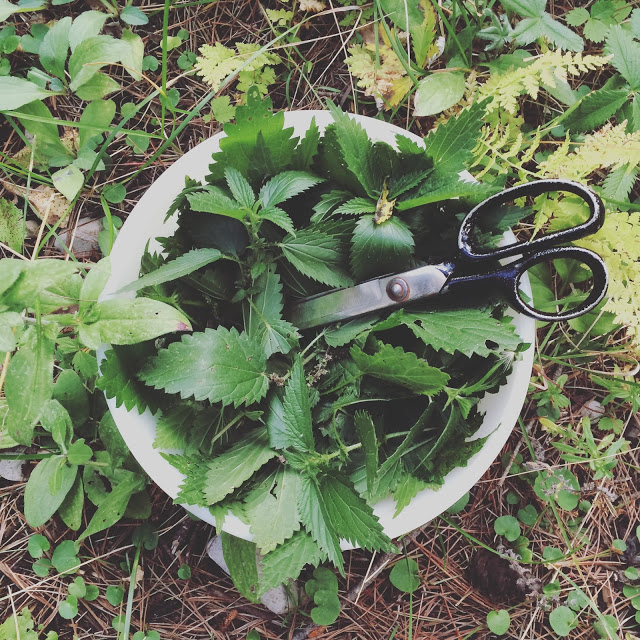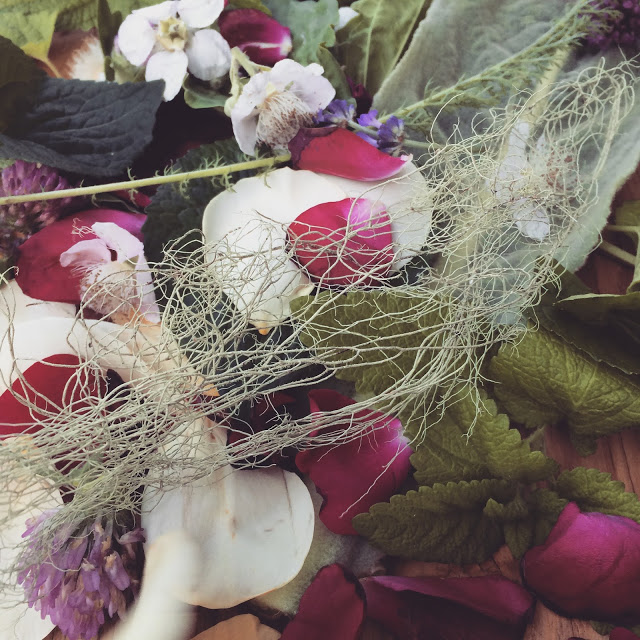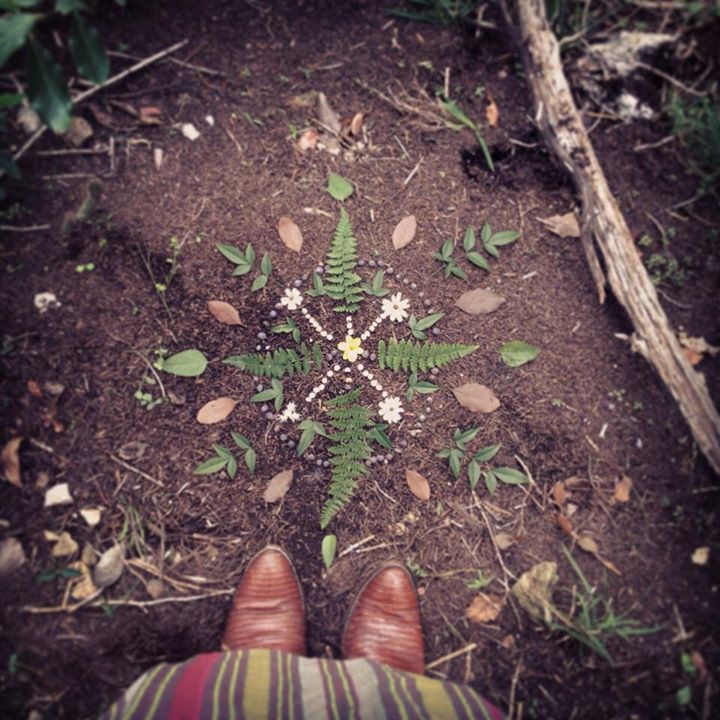
The journey of a Wildcrafter begins slowly at first. Start where you are. Allow this journey to reveal itself to you, savoring each Season and seed. Begin simply, pausing to bask in the fragrance of a beckoning bloom as Spring spreads its wings; give yourself completely to the sense of calm that ripples through your being as you dig your fingertips into the cool earth of early Autumn; bear witness to the descent of golden leaves, rustling overhead and falling circuitously back to the earth, the place from which they came. Just as much, if not more so, than any tea, tincture, or other herbal preparation you can conjure, this tonic of nature is a most potent medicine.

In an age where one can order a seemingly endless supply of herbs online with the click of a button, wildcrafting offers a precious opportunity for pause. The first thing one can expect to realize while wildcrafting is the immense satisfaction that flows from interacting with a living, breathing, sensate plant; a being with a personality and a language all its own. This interaction, while possible to have with plant material cultivated and gathered by someone else, comes far more naturally when you are face to face with a wild mountain meadow in bloom.
A second likely realization is that there are very real limits to the time you can spend in the field, as well as the amount of plants thriving in any one area which can be respectfully harvested. As one continues to cultivate a personal relationship with the Wild, it will become increasingly evident that although humans have access to a great quantity of herbal material through online sources or otherwise, the importance of being in right relationship with the landscapes from which these herbs have been harvested eclipses any desire we might have for such vast quantities of their medicine. This realization comes as a true gift, for wildcrafting puts one in touch with real Earth time, real Earth resources. When we have a relationship with the foods, the medicines, and the materials we consume, we are apt to use less of them, to find alternatives for those things which are most rare and precious, and most importantly to develop a deep sense of gratitude for all that is necessary to sustain our lives on this planet.
As wildcrafting and foraging become increasingly popular, and dare I say – trendy – it is more important than ever to bring awareness to the ethics and impacts inherent in these activities. As foragers and wildcrafters grow in number, we must – as individuals and as a community – become acutely aware of the impact we are having on our own bioregional plant communities, the indigenous peoples who have been in relationship with them for generations, and upon the Earth as a whole. The first thing to learn about gathering wild food and medicine is precisely when not to do so. What follows are guidelines for checking in with yourself, with the landscape, and with the plants themselves before taking anything from the Earth. For after all, it is from Her that we come and to Her that we shall return.

W H O L E H E A R T E D
W I L D C R A F T I N G
S E V E N S A C R E D S T E P S
for cultivating reciprocity and relationship
1. Always positively identify a plant before gathering it. Familiarize yourself with poisonous plants in your bioregion as well as plants that may closely resemble or could be mistaken for the species you intend to harvest. Drawing a plant is a great way to imprint its patterns into the recesses of your mind for later identification. And of course, when in doubt, use a definitive botanical key for positive identification.

2. Take time to truly slow down and ask permission. Gather your sincerity about you and ask the plants you feel drawn to if they would like to be harvested and used for food or medicine. Ask for consent before touching them or plucking their petals and leaves, before digging their roots. If you do not sense a definitive “yes” from the plant, move on to another stand and ask again. Be honest with yourself about what comes through. If you are unsure, trust that there are factors which may not be immediately obvious to you such as heavy metals in the soil, or a struggling plant population, which would make this an inopportune place from which to harvest. Additionally, when harvesting on public land it is essential to fully understand the laws and limitations that are likely in place which govern the gathering of wild plants. When gathering on public land, often a permit must be obtained to do so legally.

3. Thoughtfully assess the plant population and observe it for at least two turns of the wheel of the year before harvesting. When we develop a relationship with the places from which our wild foods and medicines come, it is at once more rewarding for us as humans as well as for the Land of which we are a part. Once you have watched the waxing and waning of a plant through its lifecycle and observed it thriving consistently, you will feel far more confident that you can gather it in a way that will not harm it or hinder its proliferation.

4. Consider that you may not be the only human, animal, or insect interested in gathering this plant. Take only what you truly need and will enjoy, making sure to leave more than enough for the plant to sustain itself as it is browsed by other creatures still to come. Less is more when it comes to gathering wild plants. Always take time to reflect on what other roles this plant might be playing in the ecosystem of which it is a part. For example, in desert regions many species act as nurse plants, providing much needed shade for seedlings as well as insects, birds, and small rodents.

5. Only harvest if you the have time and space to appropriately process and store the medicine you are going to harvest. Will it need to be tinctured, dried, or otherwise made use of quickly? Do you have time in the coming days or weeks to devote to properly processing it? If your apothecary shelves are already spilling over with the harvest from seasons passed or herbs you have gathered from elsewhere, consider that using the medicine you have before acquiring more may be the wise choice.

6. Keep good records. A journal which details when and where you harvested each plant ally is indispensable. Record anything noteworthy such as rain conditions in recent weeks, an unusual proliferation of flowers or fruit, and things to keep an eye on for future harvests. In this way, you will begin to develop a yearly rhythm and internalized map of your harvest. It may encompass your neighborhood streets in Summer or extend to include a cross-country journey which begins at the first hint of Spring and lasts into Autumn. We’ve created a downloadable + printable PDF that you can use as is or build off of to suit your own needs.
D O W N L O A D O U R F R E E

7. Become a steward. Hunter-gatherer societies developed extremely sophisticated methods for managing wild plant populations. Do your part to propagate the wild plants you like, and if you have access to a yard or garden, begin to cultivate your favorite wild native plants there as well. Educate yourself about what plants in your area may be threatened or endangered. Do not harvest these, or do so with great respect and sparingly. Develop a perennial relationship with the places where you wildcraft, year after year, and share their location with only a trusted few. If introducing others to wildcrafting locations, carefully consider the possibility that they too may bring people, who may bring people, and so on. Make a wise decision about whether or not the area can sustain such harvesting. Take time to leave any place you have harvested from more brimming with beauty than when you found it. Leave an offering of a nature mandala, water the trees and plants if they are in need of it, gather trash that may be scattered about, or bless the space with a song or prayer, leaving the Earth shimmering in the wake of your presence.

By following the guidelines above, and developing tenets and practices of your own, you’ll grow evermore in tune with the turning of the Seasons, with the plants as kin, with the Landscape traversed, and ultimately—wonderfully—with your Self. For the most essential teaching of the Wild is the interconnectedness of all things. The more time you spend in those places untamed and untouched, the more you will find that you truly are a part of something much larger and more magnificent than the rational mind could ever fully grasp, and which must instead be felt through the Heart.
Further Learning
Wildcrafting : An Indigenous Perspective [ Karyn Sanders ]
Wildcrafting For The Practicing Herbalist [ Seven Song ]
Wildcrafting For Beginners [ Howie Brownstien ]
How To Wildcraft In Seven Easy Steps [ Rebecca Altman ]

Be sure to share your own examples of reciprocity on Instagram using the hashtag #WholeheartedWildcrafting and follow the hashtag to learn from the good work of others.
